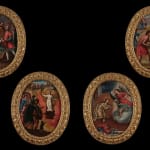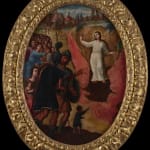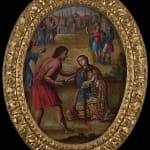
The Miracle of Saint Agnes

The Detention of Saint Agnes

Saint Agnes Sentenced in a Brothel

The Martyrdom of Saint Agnes
Four Episodes of The Story of Saint Agnes of Rome, First half of the 18th century
Cuzco (Peru), first half of the 18th century
Oil on canvas
Further images
Provenance
Private collection, The United States of America.
This series of four little oval panels originating from Cuzco and depicting the life of St. Agnes of Rome constitutes an important graphic narrative from an iconographic point of view within the context of Viceroyalty art. The hagiography of this young Roman saint has been transposed on many occasions onto pictorial and sculptural supports, with the resultant compositions falling into two core groups. Firstly, those that opt to portray the virginal figure with an abundance of attributes, but distanced from the tempestuous events that marked her short life. It is thus that from the earliest representations characteristic of the Romanesque period, until well into the 18th century, we find numerous examples of St. Agnes, on her own, accompanied by the lamb, palm of martyrdom and crown, her three recurring attributes. Secondly, and as an alternative compositional group, there are those scenographic representations in which one observes one or more of the varying forms of martyrdom to which the Saint was subjected, and it is into this group that the works we are studying here fall, their serial composition being of particular interest, an approach that is undoubtedly original in the canons of both the Old World and the New.
read essay





